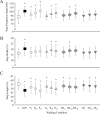Dynamic stability and stepping strategies of young healthy adults walking on an oscillating treadmill
- PMID: 30759162
- PMCID: PMC6373955
- DOI: 10.1371/journal.pone.0212207
Dynamic stability and stepping strategies of young healthy adults walking on an oscillating treadmill
Abstract
Understanding how people modify their stepping to maintain gait stability may provide information on fall risk and help to understand strategies used to reduce loss of balance. The purpose of this study was to identify the stepping strategies healthy young individuals select to maintain balance while walking on a destabilizing surface in various directions. A treadmill mounted on top of a 6 degree-of-freedom motion base was used to generate support surface oscillations in different degrees of freedom and amplitudes. Fifteen healthy young adults (21.3 ± 1.4 years) walked at self-selected speeds while continuous sinusoidal oscillations were imposed to the support surface in a one degree of freedom: rotation or translation in the mediolateral (ML) direction and rotation or translation in the anteroposterior (AP) direction, with each condition repeated at three different amplitudes. We compared step width, length, and frequency and the mean and variability of margin of stability (MoS) during each experimental walking condition with a control condition, in which the support surface was stationary. Subjects chose a common strategy of increasing step width (p < 0.001) and decreasing step length (p = 0.008) while increasing mediolateral MoS (p < 0.001), particularly during oscillations that challenged frontal plane control, with rotations of the walking surface producing the greatest changes to stepping.
Conflict of interest statement
The authors have declared that no competing interests exist.
Figures



Similar articles
-
Narrow-based gait in people with Parkinson's disease: Its mechanisms explored.J Parkinsons Dis. 2025 Mar;15(2):329-337. doi: 10.1177/1877718X241313333. Epub 2025 Feb 2. J Parkinsons Dis. 2025. PMID: 39973508
-
Effects of narrow base gait on mediolateral balance control in young and older adults.J Biomech. 2016 May 3;49(7):1264-1267. doi: 10.1016/j.jbiomech.2016.03.011. Epub 2016 Mar 16. J Biomech. 2016. PMID: 27018156
-
A novel robot for imposing perturbations during overground walking: mechanism, control and normative stepping responses.J Neuroeng Rehabil. 2016 Jun 11;13(1):55. doi: 10.1186/s12984-016-0160-7. J Neuroeng Rehabil. 2016. PMID: 27287551 Free PMC article.
-
Walking in an unstable environment: strategies used by transtibial amputees to prevent falling during gait.Arch Phys Med Rehabil. 2013 Nov;94(11):2186-93. doi: 10.1016/j.apmr.2013.07.020. Epub 2013 Aug 2. Arch Phys Med Rehabil. 2013. PMID: 23916618 Clinical Trial.
-
The influence of step width on balance control and response strategies during perturbed walking in healthy young adults.J Biomech. 2023 Aug;157:111731. doi: 10.1016/j.jbiomech.2023.111731. Epub 2023 Jul 17. J Biomech. 2023. PMID: 37494856
Cited by
-
The Effect of Human Settlement Pedestrian Environment on Gait of Older People: An Umbrella Review.Int J Environ Res Public Health. 2023 Jan 14;20(2):1567. doi: 10.3390/ijerph20021567. Int J Environ Res Public Health. 2023. PMID: 36674319 Free PMC article.
-
Small directional treadmill perturbations induce differential gait stability adaptation.J Neurophysiol. 2022 Jan 1;127(1):38-55. doi: 10.1152/jn.00091.2021. Epub 2021 Dec 1. J Neurophysiol. 2022. PMID: 34851745 Free PMC article.
-
Electrical Stimulation of Distal Tibial Nerve During Stance Phase of Walking May Reverse Effects of Unilateral Paw Pad Anesthesia in the Cat.Motor Control. 2022 Oct 31;27(1):71-95. doi: 10.1123/mc.2022-0096. Print 2023 Jan 1. Motor Control. 2022. PMID: 36316008 Free PMC article.
-
Rethinking margin of stability: Incorporating step-to-step regulation to resolve the paradox.J Biomech. 2022 Nov;144:111334. doi: 10.1016/j.jbiomech.2022.111334. Epub 2022 Oct 3. J Biomech. 2022. PMID: 36244320 Free PMC article.
-
Biomechanical Correlates of Falls Risk in Gait Impaired Stroke Survivors.Front Physiol. 2022 Mar 7;13:833417. doi: 10.3389/fphys.2022.833417. eCollection 2022. Front Physiol. 2022. PMID: 35330930 Free PMC article.
References
-
- Winter DA, Patla AE, Frank JS, Walt SE. Biomechanical walking pattern changes in the fit and healthy elderly. Phys Ther. 1990;70(6):340–7. Epub 1990/06/01. . - PubMed
-
- Menz HB, Lord SR, Fitzpatrick RC. Age-related differences in walking stability. Age Ageing. 2003;32(2):137–42. Epub 2003/03/05. . - PubMed
Publication types
MeSH terms
LinkOut - more resources
Full Text Sources

